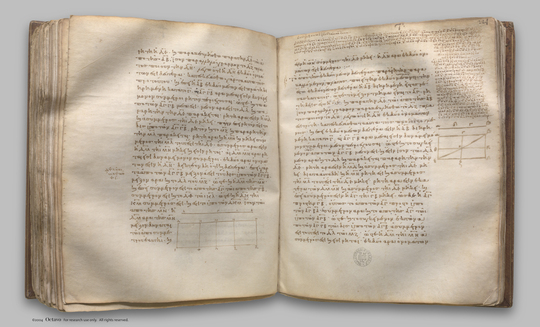index prev next | digilib folio 228

The square on the second bimedial straight line applied to a rational straight line produces as breadth the third binomial.
| Τὸ ἀπὸ τῆς ἐκ δύο μέσων δευτέρας παρὰ ῥητὴν παραβαλλόμενον πλάτος ποιεῖ τὴν ἐκ δύο ὀνομάτων τρίτην. Ἔστω ἐκ δύο μέσων δευτέρα ἡ ΑΒ διῃρημένη εἰς τὰς μέσας κατὰ τὸ Γ, ὥστε τὸ μεῖζον τμῆμα εἶναι τὸ ΑΓ, ῥητὴ δέ τις ἔστω ἡ ΔΕ, καὶ παρὰ τὴν ΔΕ τῷ ἀπὸ τῆς ΑΒ ἴσον παραλληλόγραμμον παραβεβλήσθω τὸ ΔΖ πλάτος ποιοῦν τὴν ΔΗ: λέγω, ὅτι ἡ ΔΗ ἐκ δύο ὀνομάτων ἐστὶ τρίτη. Κατεσκευάσθω τὰ αὐτὰ τοῖς προδεδειγμένοις. καὶ ἐπεὶ ἐκ δύο μέσων δευτέρα ἐστὶν ἡ ΑΒ διῃρημένη κατὰ τὸ Γ, αἱ ΑΓ, ΓΒ ἄρα μέσαι εἰσὶ δυνάμει μόνον σύμμετροι μέσον περιέχουσαι: ὥστε καὶ τὸ συγκείμενον ἐκ τῶν ἀπὸ τῶν ΑΓ, ΓΒ μέσον ἐστίν. καί ἐστιν ἴσον τῷ ΔΛ: μέσον ἄρα καὶ τὸ ΔΛ. καὶ παράκειται παρὰ ῥητὴν τὴν ΔΕ: ῥητὴ ἄρα ἐστὶ καὶ ἡ ΜΔ καὶ ἀσύμμετρος τῇ ΔΕ μήκει. διὰ τὰ αὐτὰ δὴ καὶ ἡ ΜΗ ῥητή ἐστι καὶ ἀσύμμετρος τῇ ΜΛ, τουτέστι τῇ ΔΕ, μήκει: ῥητὴ ἄρα ἐστὶν ἑκατέρα τῶν ΔΜ, ΜΗ καὶ ἀσύμμετρος τῇ ΔΕ μήκει. καὶ ἐπεὶ ἀσύμμετρός ἐστιν ἡ ΑΓ τῇ ΓΒ μήκει, ὡς δὲ ἡ ΑΓ πρὸς τὴν ΓΒ, οὕτως τὸ ἀπὸ τῆς ΑΓ πρὸς τὸ ὑπὸ τῶν ΑΓΒ, ἀσύμμετρον ἄρα καὶ τὸ ἀπὸ τῆς ΑΓ τῷ ὑπὸ τῶν ΑΓΒ. ὥστε καὶ τὸ συγκείμενον ἐκ τῶν ἀπὸ τῶν ΑΓ, ΓΒ τῷ δὶς ὑπὸ τῶν ΑΓΒ ἀσύμμετρόν ἐστιν, τουτέστι τὸ ΔΛ τῷ ΜΖ: ὥστε καὶ ἡ ΔΜ τῇ ΜΗ ἀσύμμετρός ἐστιν. καί εἰσι ῥηταί: ἐκ δύο ἄρα ὀνομάτων ἐστὶν ἡ ΔΗ. Δεικτέον [ δή ], ὅτι καὶ τρίτη. Ὁμοίως δὴ τοῖς προτέροις ἐπιλογιούμεθα, ὅτι μείζων ἐστὶν ἡ ΔΜ τῆς ΜΗ, καὶ σύμμετρος ἡ ΔΚ τῇ ΚΜ. καί ἐστι τὸ ὑπὸ τῶν ΔΚΜ ἴσον τῷ ἀπὸ τῆς ΜΝ: ἡ ΔΜ ἄρα τῆς ΜΗ μεῖζον δύναται τῷ ἀπὸ συμμέτρου ἑαυτῇ. καὶ οὐδετέρα τῶν ΔΜ, ΜΗ σύμμετρός ἐστι τῇ ΔΕ μήκει. Ἡ ΔΗ ἄρα ἐκ δύο ὀνομάτων ἐστὶ τρίτη: ὅπερ ἔδει δεῖξαι. | The square on the second bimedial straight line applied to a rational straight line produces as breadth the third binomial. Let AB be a second bimedial straight line divided into its medials at C, so that AC is the greater segment; let DE be any rational straight line, and to DE let there be applied the parallelogram DF equal to the square on AB and producing DG as its breadth; I say that DG is a third binomial straight line. Let the same construction be made as before shown. Then, since AB is a second bimedial divided at C, therefore AC, CB are medial straight lines commensurable in square only and containing a medial rectangle, [X. 38] so that the sum of the squares on AC, CB is also medial. [X. 15 and 23 Por.] And it is equal to DL; therefore DL is also medial. And it is applied to the rational straight line DE; therefore MD is also rational and incommensurable in length with DE. [X. 22] For the same reason, MG is also rational and incommensurable in length with ML, that is, with DE; therefore each of the straight lines DM, MG is rational and incommensurable in length with DE. And, since AC is incommensurable in length with CB, and, as AC is to CB, so is the square on AC to the rectangle AC, CB, therefore the square on AC is also incommensurable with the rectangle AC, CB. [X. 11] Hence the sum of the squares on AC, CB is incommensurable with twice the rectangle AC, CB, [X. 12, 13] that is, DL is incommensurable with MF, so that DM is also incommensurable with MG. [VI. 1, X. 11] And they are rational; therefore DG is binomial. [X. 36] It is to be proved that it is also a third binomial straight line. In manner similar to the foregoing we may conclude that DM is greater than MG, and that DK is commensurable with KM. And the rectangle DK, KM is equal to the square on MN; therefore the square on DM is greater than the square on MG by the square on a straight line commensurable with DM. And neither of the straight lines DM, MG is commensurable in length with DE. |